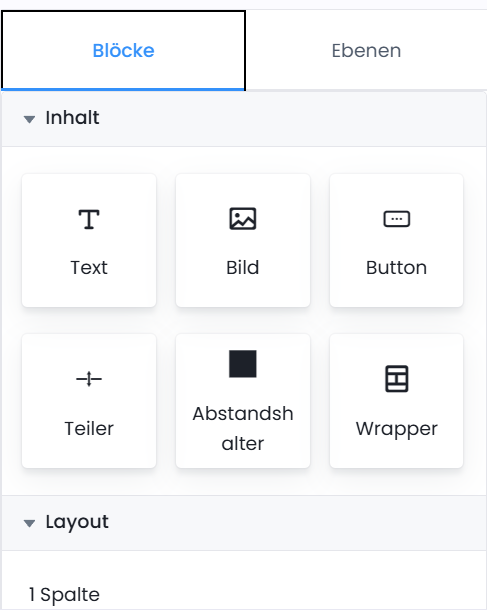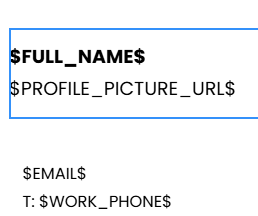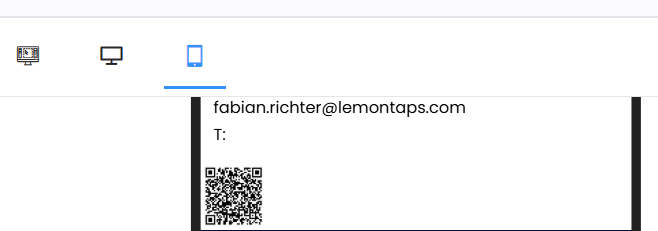Create an email signature: How to create a professional appearance
Email is still one of the most important means of communication in the business world. This makes the impression you leave at the end of every message all the more important. An email signature is much more than just a nice finishing touch: it is a digital business card, brand ambassador and trust anchor all in one. In this article, we show you step by step how to create a professional email signature - with lots of practical tips and a tool that will make your work much easier.
What belongs in a professional email signature?
-
A good signature provides all relevant information at a glance - but without being overloaded. These elements belong in every professional signature:
-
Name and position: So that your recipient knows who he or she is talking to.
-
Company: The company name should be clearly recognizable.
-
Contact information: Email address (yes, even if it's in the mail), phone number and your website if applicable.
-
Logo or photo: For recognition and trust.
-
Links to social media accounts: Particularly important for marketing, sales or personal branding.
-
Disclaimer (optional): For legal notices, e.g. for confidential content.
Keep the information clear and structured - less is often more.
-

Example signature with QR code for the digital business card
![]() Create e-mail signature with Lemontaps
Create e-mail signature with Lemontaps
Lemontaps has its own in-house editor based on the modular principle, which you can use to create a mail signature in Outlook. This guide shows you how to create an attractive signature step-by-step.
-
Prerequisite: Lemontaps account
You need a Lemontaps account to access this feature -
Edit the right signature
With Lemontaps you can create your own signatures for different languages and different units. Make sure you have selected the appropriate template here.
-
Design the layout and content
The modular principle makes creating appealing signatures child's play. You still have complete freedom over the design of your signature - and can choose between many elements and layouts
-
Use variables for your signature
This feature is worth its weight in gold: variables are used to pull data such as name, position or telephone number directly from the stored data - so all data is correct at all times - particularly practical if you are a team and have to manage many signatures.
-
Use an eye-catcher
Insert an eye-catching element - such as an image - to draw the reader's attention. However, make sure that the design remains appealing.
-
Check your signature
Finally, go through all the elements again. Check that the formatting is correct and that all placeholders are correct. You can also switch the view to "Mobile devices" to see whether the signature also looks good on cell phones. To be on the safe side, send yourself a test email before you use the signature.
-
Save your signature
It's actually self-explanatory, but it's still often forgotten. Save your signature. Have fun with your new signature from LemontapsWith these instructions, your new signature is guaranteed to be an eye-catcher. If you are interested in topics related to the Lemontaps signature software, you can find more information here.
Design tips for a professional email signature
Even if you formulate all the content well - without a well thought-out layout, the effect is lost. Here are specific recommendations that you should bear in mind when designing your signature:
1. reduction to the essentials
Less is more. A signature should not replace half a website. Instead, it's about clear, quick orientation. Use line breaks to separate sections (e.g. name & role, contact, social media) and limit yourself to what is really relevant.
2. consistent fonts and sizes
Stick to one, maximum two, fonts - ideally the same as in your corporate identity (e.g. in your newsletter or on the website). For readability on all devices, a standard font such as Arial, Helvetica or Calibri is recommended. The look should be harmonious and the design well thought out.
3. use color accents sensibly
Colors bring a signature to life, but only if they are used in a targeted manner. For example, use branding elements, such as your company colors, for the icons (telephone, mail, social media) or for dividing lines. Make sure there is sufficient contrast - especially with a white background.
4. integrate images and logos correctly
A company logo or a portrait photo creates trust and ensures recognition. However, pay attention to the size: images under 100 KB are ideal so that they do not increase the loading time. And important: the image should also be meaningfully integrated if e-mail programs initially block it.
5. do not forget responsive design
The majority of your emails are read on your smartphone. A signature that is displayed there in miniature font or completely distorted does not leave a good impression.
The aim: Your signature should be professional, clear and brand-compliant. This will convey to the recipient that you are ambitious and identify with your brand.

5 mistakes you should avoid
Even if it sounds simple - the same mistakes are often made when designing and using email signatures. Here are the five most common ones and how to avoid them:
1. the signature is overloaded
Some signatures read like a CV: title, departments, four telephone numbers, five links and a poem at the end. This looks unprofessional and is off-putting. Rule of thumb: a maximum of 4-5 lines of main information, the rest should be linked or optional.
2. images are embedded incorrectly
An image that is displayed as a file attachment creates confusion. Logos that are too large or pixelated photos do not make a good impression either. Images should be embedded directly in the HTML code so that they are displayed correctly - even in Outlook or Apple Mail.
3. outdated or incorrect information
An old telephone number or a dead link in the signature - classic pitfalls. Check your data regularly. Even better: use a central administration system like Lemontaps, where changes are automatically applied to the entire team.
4. unprofessional content
A smiley face at the end, a quote from Einstein or a semi-ironic farewell greeting - what may seem likeable on a personal level is usually out of place in a business context. A signature should radiate clarity and competence, not a mood or private humor.
5. no uniform solution in the team
If every employee in the company uses a different signature - in terms of style, logo or order - it looks chaotic. Consistent signatures strengthen the brand image and ensure that your communication also appears visually as a team.
If you avoid these 5 mistakes, your email signature will already be significantly better than your competitors.
Bonus: digital business card as an extension to the signature
The classic signature has its limits - especially in terms of content. A digital business card goes one step further and makes your signature interactive.
With Lemontaps you can link directly from your email signature to a personal business card - a mini landing page that presents you as a professional contact:
This is what the digital business card brings you:
-
All resources at a glance: In addition to contact details, calendar links (e.g. for appointment bookings), PDFs (e.g. white papers), portfolio links or video intros can also be included.
-
Easy to share: The digital business card can be shared via QR code or link. Not only in the signature, but also in meetings, at trade fairs or with LinkedIn contacts.
-
Measurable & dynamic: You can track how often the map is accessed, which links have been clicked and what works well. Tracking gives you a real advantage over the "static" signature.
-
Always up-to-date: If your telephone number or role changes, the information is changed in real time - without you having to inform each contact individually.
The best thing is that the digital business card is not a substitute, but a clever addition. Those who use them show digital progress, professionalism and make it easy for their counterparts to stay in touch.
Conclusion
A professional email signature is not a "nice to have", but a must for anyone who wants to appear serious. It not only conveys information, but also trust and brand competence. With Lemontaps, you can design this important touchpoint in a modern, efficient and consistent way - whether as an individual or for an entire team.
So: no more copy-paste signatures. Design your digital presence - simply and effectively.
If you would like to test the Lemontaps email signature generator and see the online editor for yourself, you can simply book an appointment. Otherwise, you can find more information about creating email signature templates with Lemontaps here.


 Contact sales
Contact sales
 Support
Support
 Login
Login



